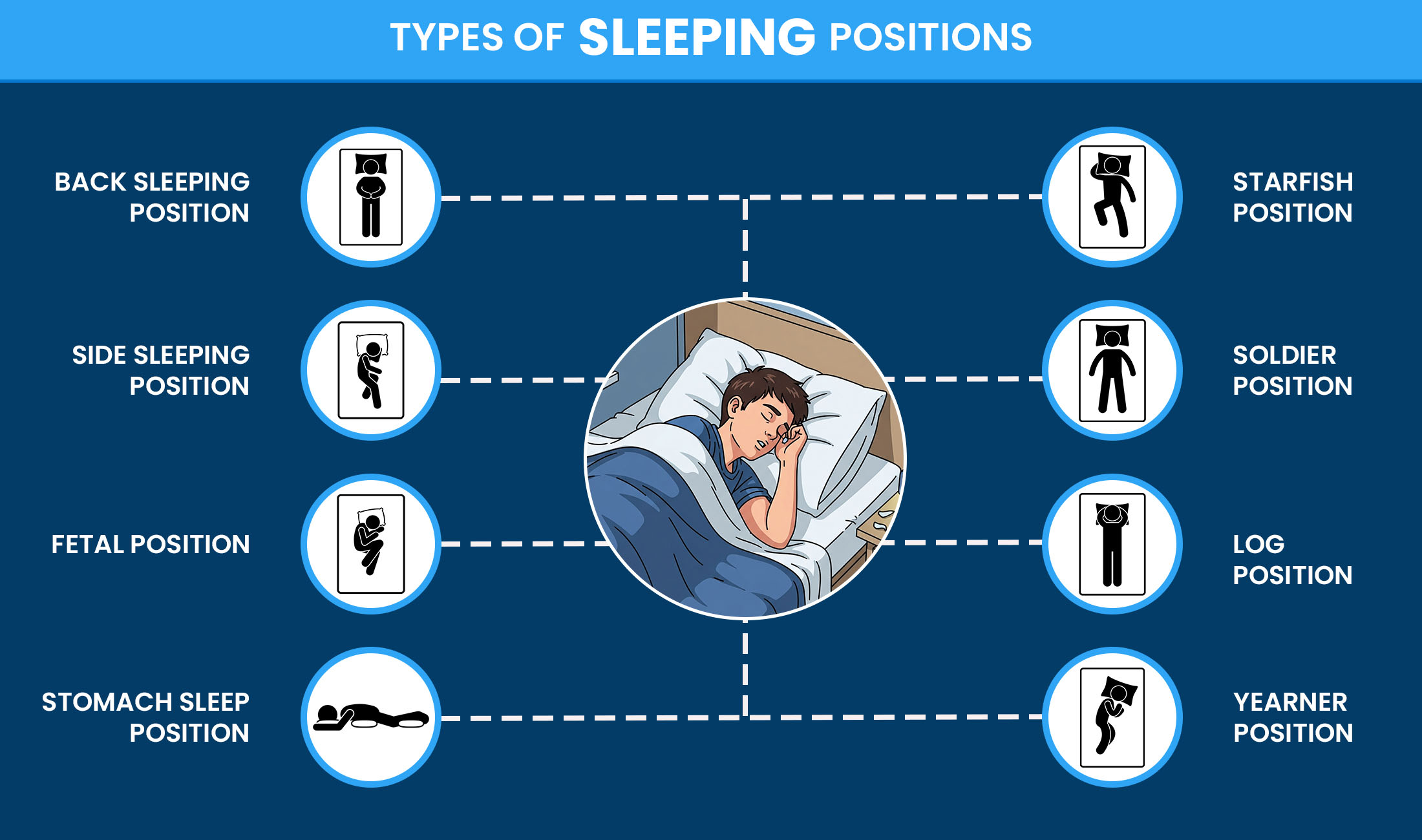Most people experience difficulties in sleeping in awkward postures, which causes discomfort, neck pain, or poor quality of sleep. According to studies, about 50% of the population suffers from sleep-related problems, most of which arise from improper sleeping postures. Sleeping in a poor posture may lead to long-term spinal problems and muscle stiffness. With the right adjustments, however, it’s possible to break free from these bad habits and enjoy more restful, pain-free nights. Let’s explore effective ways to improve your sleep posture and wake up feeling refreshed.
Types of Weird Sleeping Positions
Here are some weird sleeping positions that should not be your priority:
- Side-sleepers/fetal position sleepers
- Log-sleepers
- The yearner
- Free-falling stomach-sleepers
- Starfish-sleepers
- Spooning-sleepers
Pros and Cons Chart
| Sleeping Position | Pros | Cons |
|---|---|---|
| Side-Sleepers/Fetal | Reduces snoring, helps with heartburn, and is suitable for pregnant women | Shoulder and hip pain, possible neck strain |
| Log-Sleepers | Good spinal alignment, low neck strain | Shoulder stiffness reduces blood flow if not switching sides |
| The Yearner | Helps spinal alignment, relieves lower back pain | Shoulder/neck strain, possible muscle tension |
| Free-Falling Stomach | Reduces snoring, comforting for some | Neck and back strain worsens spinal alignment, restricts breathing |
| Starfish-Sleepers | Relieves pressure on the back and is good for spinal alignment | Shoulder and hip discomfort can worsen snoring |
| Spooning-Sleepers | Intimacy, relaxation, reduces stress | Can cause discomfort, back/shoulder pain, limited movement |
1. Side-Sleepers/Fetal Position Sleepers
The most common position is side sleeping, which resembles a curled-up fetal position. It's normal for many people since it feels comfortable and secure. However, it has some downsides if not done the right way.
Pros:
- Helps reduce snoring and sleep apnea symptoms.
- Eases heartburn or acid reflux.
- Great for pregnant women, as it promotes circulation.
Cons:
- Can cause shoulder and hip pain if unsupported.
- Poor alignment can strain the neck and spine.
- Might increase wrinkles over time due to pressure on the face.
2. Log-Sleepers
Log sleepers lie flat on their sides with both arms down. This position keeps the body aligned but sometimes results in stiffness.
Pros:
- Good for spinal alignment, especially if you use the right pillow.
- Low risk of neck strain when done correctly.
Cons:
- Can cause shoulder stiffness from the pressure of the arms resting by your sides.
- May restrict blood flow if you don’t change sides regularly.
3. The Yearner
Yearners sleep on their sides with arms stretched out in front of them like they are reaching for something. This is a typical sleeping position for those who desire security.
Pros:
- Helps keep the spine aligned and reduces pressure on the back.
- Relieves lower back pain for some sleepers.
Cons:
- Can cause shoulder or neck strain due to the arm positioning.
- May create muscle tension if the arm is unsupported for too long.

4. Free-Falling Stomach-Sleepers
Free-fallers sleep on their stomachs, wrap their arms around a pillow, or stretch them out. Such a position seems comfortable for some people, but it will strain the body.
Pros:
- Helps reduce snoring by preventing airway obstruction.
- May feel comforting or secure for some individuals.
Cons:
- Puts a lot of pressure on the neck, leading to neck and spine pain.
- Can worsen back pain due to poor spinal alignment.
- Restricts breathing and may increase strain on internal organs.
5. Starfish-Sleepers
Starfish sleepers stretch themselves on their backs and make their arms and legs open. Such a position tends to occupy much space, thus causing discomfort.
Pros:
- Relieves pressure on the back and neck if supported by pillows.
- Improves spinal alignment if you sleep on your back.
Cons:
- May cause shoulder and hip discomfort due to the spread-out position.
- Could worsen snoring or sleep apnea for some people.
6. Spooning-Sleepers
The most popular position is spooning, in which one person curls up behind the other. Such a cozy position does have its pros and cons regarding intimacy and comfort.
Pros:
- Provides warmth and a sense of closeness for couples.
- Can promote relaxation and better sleep by reducing stress.
Cons:
- Can be uncomfortable for one partner due to limited space.
- May cause back or shoulder pain if the body isn't properly supported.
- Could restrict movement during sleep, leading to stiffness.
Tips to Avoid Sleeping in Weird Positions
If you wake up during the night frequently in awkward sleeping positions, there are numerous ways to improve your posture and eventually have a good night's sleep. Here are some helpful tips:
1. Use Supportive Pillows
Choose pillows that support your neck and spine properly. A right pillow can help maintain alignment, especially for side or back sleepers. A thicker side sleeper pillow is also needed for side sleeping to fill the gap between your head and shoulder.
2. Try Sleep Position Training
One can train the body to sleep in healthier positions. So, for example, you place a pillow under the lower back of a side sleeper so you can't roll onto your stomach; in that way, the pillows maintain a natural curve to your back if you sleep on your back.
3. Invest in a Good Mattress
A mattress is a must to keep you aligned to your sleeping style. It is best to have the medium-firm mattress in most cases since it's not too rigid but allows support.
4. Avoid Sleeping on Your Stomach
Stomach sleeping can be very hazardous to your neck and the spine. If you avoid it, try to get a thin pillow under your tummy to relieve some tension on your back.
5. Practice Relaxation Techniques Before Bed
Stress can also lead to sleep patterns of a restless nature and even unusual positions. Meditation, deep breathing exercises, or light stretching before bedtime can relax your body and mind.
6. Create a Sleep Schedule
A regular sleep schedule gives the body a natural and comfortable position. Don't distract yourself with electronics before bed; this enhances relaxation and a deeper sleep.
7. Use Body Positioning Aids
When you catch yourself adopting unhealthy sleep positions, support yourself with body pillows, wedge pillows, or even a sleep belt to remind your body to maintain its healthy position throughout the night.
8. Strengthen Your Core and Back
Poor posture during sleep can be due to a weak core. This can be improved by exercises that strengthen the abdominal and back muscles, which enables you to maintain better alignment while resting.
Final Thoughts
Sleeping in awkward positions is known to cause discomfort and even neck pain, while causing long-term posture issues. However, with the proper adjustments, such as the use of supportive pillows, investment in a quality mattress, and practicing relaxation techniques, you can transform your sleep experience. Recognizing the pros and cons of your sleeping position is key to making small changes that promote proper alignment and a healthier night's rest.
In short, by focusing your sleeping posture, you may wake up feeling refreshed and unharmed by stiffness and pain. Whether it involves the avoidance of stomach sleep or strengthening of the muscles within your core, making such simple steps will get you comfortable and enhance general wellness, allowing you to rest at peace.














